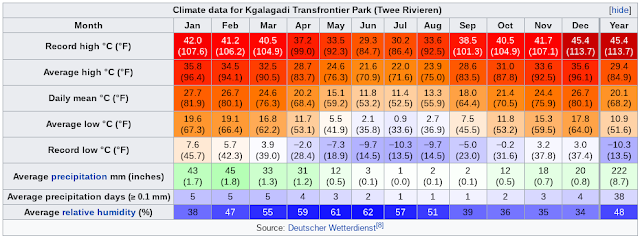The park is situated in the arid to semi-arid southern Kalahari region. The southwestern Kalahari
falls within a summer rainfall area and the mean annual rainfall ranges from 120 mm in the southwest to 350 mm in the northeast into Botswana. Rainfall is highly erratic and at a specific locality can vary from less than a 100 mm up to more than 450 mm per annum.
By 2050, average temperatures in the park are expected to increase by between 1.7 ℃ and 2.9 ℃ (DEA, 2013; Driver et al. 2012; Holness & Bradshaw, pers. comm.). While average increases of 1 ℃ - 3 ℃ may not appear alarming, they will have significant impacts.
No major rainfall changes have been detected in the historical rainfall record for the past 50 years, although missing data could have played a role in this. Medium and high risk scenarios predict a decrease of between 31 mm and 95 mm in rainfall by 2050 (DEA, 2013; Driver et al.2012; Holness & Bradshaw, pers. comm.).
falls within a summer rainfall area and the mean annual rainfall ranges from 120 mm in the southwest to 350 mm in the northeast into Botswana. Rainfall is highly erratic and at a specific locality can vary from less than a 100 mm up to more than 450 mm per annum.
The highest rainfall occurs in the four months January to April, with a peak in March. Annual rainfall has a high coefficient of variation and the rain often falls as short–duration, high-intensity thunderstorms.
Temperatures are extreme with winter lows reaching -10.3 ℃ and summer highs reaching up to 45.4 ºC (Van Rooyen et al., 1990). The relative humidity is low and the annual evaporation rate is high.
By 2050, average temperatures in the park are expected to increase by between 1.7 ℃ and 2.9 ℃ (DEA, 2013; Driver et al. 2012; Holness & Bradshaw, pers. comm.). While average increases of 1 ℃ - 3 ℃ may not appear alarming, they will have significant impacts.
Analysis of weather data from Twee Rivieren over the last 50 years (1960 - 2009), showed a 1.2 ℃ increase in average minimum and 1.95 ℃ increase in average maximum temperature (van Wilgen et al.,2016). Though these changes might sound small, these increases have resulted in an increase of a massive 37 additional days (compared to 1960) per year where the temperature exceeds 35 ℃.
No major rainfall changes have been detected in the historical rainfall record for the past 50 years, although missing data could have played a role in this. Medium and high risk scenarios predict a decrease of between 31 mm and 95 mm in rainfall by 2050 (DEA, 2013; Driver et al.2012; Holness & Bradshaw, pers. comm.).
This driest scenario would effectively mean no rainfall for the region. The wettest scenario would see an increase in rainfall of 64 mm per year, but this scenario is less likely. No major changes in the distribution of the savanna biome are predicted for the park under intermediate scenarios.
However, under the driest predicted future, up to 80% of the park would have climatic conditions more similar to desert or succulent Karoo than savanna. Unbearably hot temperatures throughout most of the year could become a reality. Along with predicted drying trends, this has huge implications for wildlife and tourism.
Warmer temperatures also mean faster evaporation of any rain that does fall, which will further exacerbate the current water availability and quality problems. There is a possibility that the area will face a decline in tourism, especially if charismatic fauna and flora are also negatively affected.

